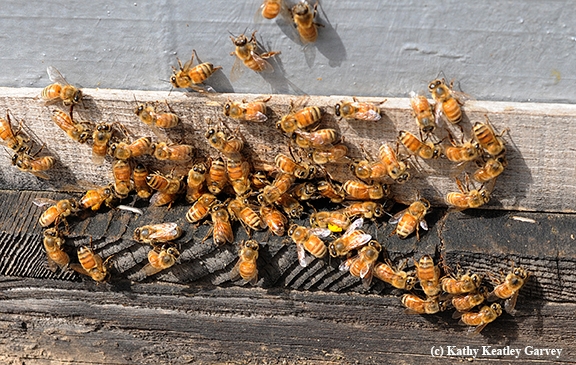
Posts Tagged: marijuana
UC Cooperative Extension reaching out to NorCal cannabis growers
UC Cooperative Extension in Humboldt County has invited local cannabis farmers to meetings this week to discuss ways to reduce the industry's environmental impacts, reported Will Houston in the Eureka Times-Standard.
UC advisors and specialists will discuss future research aimed at reducing the impacts of pesticide and fertilizer use on cannabis grows.

At this week's meetings, Giraud said, "Mostly we just want to listen to folks who come to the meetings ideas and concerns. They're on the ground. We just want to know what could be planned with us."
The meetings will be from 6 to 8 p.m. Oct. 3 at Adriana's Restaurant, 850 Crescent Way, Arcata; and 12 to 2 p.m. Oct. 4 at Women's Civic Club, 477 Maple Lane, Garberville.
There will be brief presentations followed by group discussions. The UC participants include Van Butsic, UC Cooperative Extension land use science specialist at UC Berkeley; Kent Daane, UCCE biological control specialist at UC Berkeley; Houston Wilson, post-doctoral researcher at UC Berkeley; and Giraud.
Insight into the environmental impacts of cannabis agriculture

A recent study led by UC Cooperative Extension specialist Van Butsic used high resolution satellite imagery to conduct a systematic survey of cannabis production and to explore its potential ecological consequences.
Published this spring in Environmental Research Letters, the study focused on the “emerald-triangle” in northern California's Humboldt, Mendocino, and Trinity counties, which many believe is the top cannabis-producing region in the United States.
The UC Berkeley-based Butsic and his co-author Jacob Brenner used Google Earth imagery to locate and map grow sites (both greenhouses and outdoor plots) in 60 watersheds. Most cannabis grow sites are very small, and have gone undetected when researchers used automated remote sensing techniques, which are commonly used to detect larger changes such as deforestation.
“We chose to use fine-grained imagery available in Google Earth and to systematically digitize grows by hand, identifying individual plants. Most plants stand out as neat, clear, little circles,” said Brenner, who is on the faculty of the Department of Environmental Studies and Science at Ithaca College. “The method was laborious — it took over 700 hours — but it proved to be highly accurate.”
Butsic and Brenner paired their image analysis with data on the spatial characteristics of the sites (slope, distance to rivers, distance to roads) and information on steelhead trout and Chinook salmon, both of which are listed as threatened species under the federal Endangered Species Act. These and other species are vulnerable to the low water flows, soil erosion, and chemical contamination that can result from nearby agriculture.
Results of the study show 4,428 grow sites, most of which were located on steep slopes far from developed roads. Because these sites will potentially use significant amounts of water and are near the habitat for threatened species, Butsic and Brenner conclude that there is a high risk of negative ecological consequences.
“The overall footprint of the grows is actually quite small [~2 square kiliometers], and the water use is only equivalent to about 100 acres of almonds,” says Butsic, who is in the Department of Environmental Science, Policy, and Management at Berkeley. According to Butsic, California currently has more than one million irrigated acres of almonds.
He stresses that the issue lies in the placement of the sites: “Close to streams, far from roads, and on steep slopes — cannabis may be a case of the right plant being in the wrong place.”
Last year, California legislature passed laws designed to regulate medical marijuana production, and state voters will weigh in on whether to legalize recreational marijuana this coming fall. Given these changes as well as the profitability of cannabis production, Butsic expects that marijuana cultivation will expand into other sites with suitable growing conditions throughout the region. He and Brenner assert that ecological monitoring of these hotspots should be a top priority.
Bills recently signed into law by Governor Jerry Brown have made some advances in this direction — requiring municipalities to develop land use ordinances for cannabis production, forcing growers to obtain permits for water diversions, and requiring a system to track cannabis from when it is first planted until it reaches consumers.
But the researchers say that regulation will likely be a constant challenge because it will rely on monitoring procedures that are just now emerging, as well as voluntary registration from producers and budget allocation from the state for oversight and enforcement.
“Some of the same fundamental challenges that face researchers face regulators as well, primarily that cannabis agriculture remains a semi-clandestine activity,” says Brenner. “It has a legacy of lurking in the shadows. We just don't know — and can't know — where every grow exists or whether every grower is complying with new regulations.”
The Buzz About Honey Bees and Marijuana
Extension apiculturist emeritus Eric Mussen of the UC Davis Department of Entomology and Nematology, "retired" in June of 2014 after 38 years of service but his phone and keyboard at Briggs Hall gather no dust. The honey bee guru continues to answer a range of questions. The latest concerns the...

Honey bees laden with pollen returning to their colony. (Photo by Kathy Keatley Garvey)
Perils of illegal marijuana crops

Rodenticides used on illegal marijuana farms have already been shown to pose serious harm to the fisher—a cat-sized carnivore found in forests across Canada and four regions in the U.S. (Previous news article.)
Mourad Gabriel, a doctoral candidate with the Veterinary Genetics Laboratory at UC Davis School of Veterinary Medicine, provides a more comprehensive look at the situation in the recent issue of The Wildlife Professional, put out by The Wildlife Society. (Article here.)
New information looks at risks to other species and to the ecologists and biologists conducting wildlife research on community and public lands where more of these crops are being cultivated.
Highlights include:
- Newly documented fisher mortalities (necropsies done at UC Davis’ California Animal Health and Food Safety Laboratory System)
- New data documenting just a glimpse of potential environmental degradation possibly occurring on our public lands
- First mention of toxicants like carbamates and organochlorides (DDT etc...) that are being found in California grow sites
- Provides readers with information on how some of these toxicants are placed at grow sites to maliciously poison wildlife
- New info and discussion points of "what are" the potential effects of ...such as damming water courses, putting toxic slurry of chemicals in dammed creeks, cutting riparian zones, human feces (affects salmon and many other species)
- First-hand accounts of ecologists and biologists conducting wildlife research being shot at, chased and threatened
- Quantifies the loss of project area access, and data from fisher projects in California public lands
There is also a link to a video that offers a first account visual representation of what a fisher looks like, the unfortunate visual effects of toxicosis and the realistic outcome to wildlife from these illicit activities on tribal and public lands.
For more information, contact Mourad Gabriel, mwgabriel@ucdavis.edu or Trina Wood, tjwood@ucdavis.edu
Evidence of rodenticide poisoning of wildlife found in the Sierra
There is a new predator in the forest these days. It has arisen quietly over the years. Any wildlife feeling hungry when they come upon it in the Sierra is vulnerable. This predator is amazingly small for the scope of its damage; it can’t run fast or climb high.

University of California scientists originally became aware of this problem when Rick Sweitzer, associate professor in the Department of Environmental Science, Policy and Management at UC Berkeley, and his wildlife research team retrieved a radio-collared fisher whose cause of death was unclear. Sweitzer and his team are researching are studying the fate Pacific fishers as part of the Sierra Nevada Adaptive Management Project (SNAMP).
Necropsy (an autopsy for animals) of the fisher carcass by Mourad Gabriel of UC Davis and the Integral Ecology Research Center found rodenticide poisoning to be the cause. With these new findings, the livers from previous fisher mortalities in the SNAMP study were reexamined for evidence of rodenticide exposure. They discovered that more than 80 percent of dead fishers examined had been exposed to rodenticide. These toxicants can persist in animal tissues or the environment for potentially hundreds of days. At least five dead fishers found by researchers in SNAMP and a second fisher study in northern California have been confirmed to have died of rodenticide poisoning, the scientists reported in the science journal PlusOne.
Considering the hundreds of marijuana grow sites found every year on public lands, the scale of the damage to California’s natural resources may be unprecedented. Grow sites are also found containing massive amounts of fertilizers, herbicides and pesticides, all of which are being used without concern for run off or aquatic species nearby. Marijuana plants are removed from these plots when found, but these chemicals are often left behind.
Although this problem might seem overwhelming, there are efforts to address it. The non-profit Environmental Reclamation Team has cleaned up hundreds of grow sites since 2005. They remove and document all of the poisons found along with the miles of plastic irrigation line and piles of trash. More efforts like this are needed if we are to maintain rare animals like the Pacific fisher as well as all the other species who have the potential of coming in contact with these poisons.
